
Leptoceras menziesii, commonly known as rabbit orchid, is a plant in the orchid family, Orchidaceae and the only member of the genus Leptoceras. It is a slender plant, usually found in large colonies and which only flowers after fire. The flowers are small, white, pink and red on a stem up to 30 cm (10 in) tall and is endemic to southern Australia. It was one of the first orchids from Western Australia to be described and was given the name Caladenia menziesii, a name still used by some authorities.
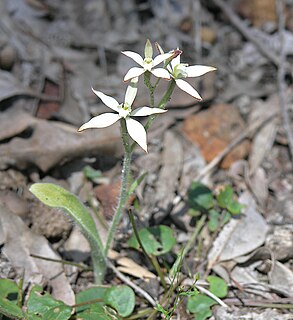
Caladenia marginata, commonly known as the white fairy orchid, is a species of orchid endemic to the south-west of Western Australia. It has a single pale green, hairy leaf and up to four creamy-white flowers and often grows in dense colonies, flowering profusely after summer fires.
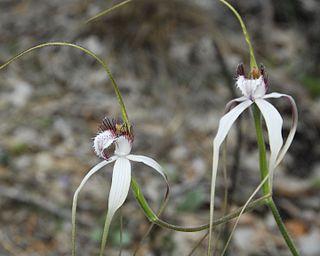
Caladenia longicauda is a species of plant in the orchid family Orchidaceae and is endemic to the south-west of Western Australia. It is distinguished by its large leaf and by its up to five large, white flowers which have drooping sepals and petals with long, thickish brown "tails".

Caladenia fuscata, commonly known as dusky fingers, is a plant in the orchid family Orchidaceae and is endemic to eastern and south-eastern Australia, including Tasmania. It is a small ground orchid found in eucalyptus woodland and which flowers in September and October.
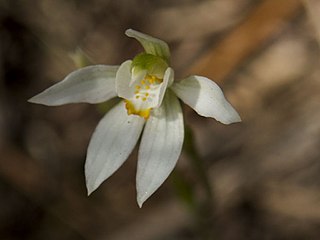
Caladenia aurantiaca, commonly known as orangetip fingers, is a plant in the orchid family Orchidaceae and is endemic to Victoria, although it is also found on one Bass Strait island. It is a slender ground orchid with a single hairy leaf and one or two short-lived, orange-tipped, white flowers on a thin, wiry spike.

Caladenia filamentosa, commonly known as daddy-long-legs, is a plant in the orchid family Orchidaceae and is endemic to eastern Australia. It is a ground orchid with a single hairy leaf and up to four, usually dark red flowers with long, drooping lateral sepals and petals.

Caladenia flava subsp. flava, commonly known as the cowslip orchid, is a species of orchid endemic to the south-west of Western Australia. It is a relatively common orchid with a single, hairy leaf and up to three golden-yellow flowers which often have red markings.
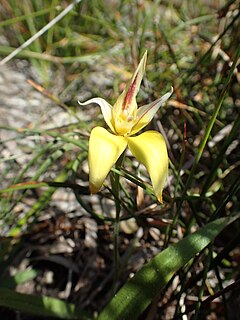
Caladenia flava subsp. sylvestris, commonly known as the karri cowslip orchid, is a species of orchid endemic to the south-west of Western Australia. It has a single, hairy leaf and up to three pale yellow and cream-coloured flowers which are white near the tips of the sepals and petals and marked with bright red or pink.
Caladenia longicauda subsp. albella, commonly known as the small-lipped white spider orchid, is a plant in the orchid family Orchidaceae and is endemic to the south-west of Western Australia. It has a single hairy leaf and up to four, mostly white flowers which have a pungent smell. It usually grows in seasonal swamps between Eneabba and Gingin.

Caladenia longicauda subsp. calcigena, commonly known as the coastal white spider orchid, is a plant in the orchid family Orchidaceae and is endemic to the south-west of Western Australia. It has a single hairy leaf and up to four mostly white flowers. It grows in coastal sand on the west coast and is distinguished from other subspecies growing in the same area, by its longer sepals and petals, small, narrow labellum and by the arrangement of the calli on its labellum.
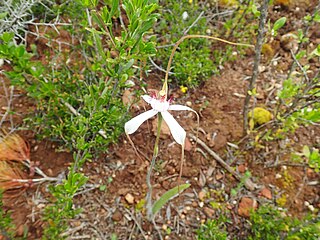
Caladenia longicauda subsp. clivicola, commonly known as the Darling Scarp white spider orchid, or hills white spider orchid is a plant in the orchid family Orchidaceae and is endemic to the south-west of Western Australia. It has a single hairy leaf and up to three mostly white flowers with long, drooping lateral sepals and petals, a relatively small, narrow labellum and narrow labellum teeth. It grows in a restricted area, mostly on the Darling Scarp.

Caladenia longicauda subsp. crassa, commonly known as the Esperance white spider orchid, is a plant in the orchid family Orchidaceae and is endemic to the south-west of Western Australia. It has a single hairy leaf and up to three mostly white flowers with long, broad, spreading lateral sepals and petals, a relatively broad labellum with short, narrow teeth. It grows on the south coast between Bremer Bay and the Cape Arid National Park.

Caladenia longicauda subsp. eminens, commonly known as the stark white spider orchid, is a plant in the orchid family Orchidaceae and is endemic to the south-west of Western Australia. It has a single hairy leaf and up to three large, bright white flowers with long, broad, spreading lateral sepals and petals, a relatively broad labellum with short, narrow teeth. It is a relatively common orchid found in a broad band, mainly between Tenterden and Jerramungup.

Caladenia longicauda subsp. longicauda, commonly known as the white spider orchid, is a plant in the orchid family Orchidaceae and is endemic to the south-west of Western Australia. It has a single hairy leaf and up to four, mostly white flowers with long drooping, thread-like ends on the sepals and petals. It grows in woodland and forest.

Caladenia longicauda subsp. merrittii, commonly known as Merritt's white spider orchid, is a plant in the orchid family Orchidaceae and is endemic to the south-west of Western Australia. It has a single hairy leaf and up to three large, mainly white flowers with very long, drooping lateral sepals and petals, and a white broad labellum with relatively short labellum teeth. It is one of the largest spider orchids.
Caladenia longicauda subsp. extrema, commonly known as the late white spider orchid or Seaton Ross spider orchid is a plant in the orchid family Orchidaceae and is endemic to the south-west of Western Australia. It has a single hairy leaf and one or two mainly white flowers with long, mostly spreading lateral sepals and petals. It is a relatively rare orchid which is similar to the tangled white spider orchid but has larger flowers and a later flowering period.
Caladenia longicauda subsp. insularis, commonly known as the island white spider orchid is a plant in the orchid family Orchidaceae and is endemic to the south-west of Western Australia. It has a single hairy leaf and up to four yellowish-white flowers with long, mostly spreading lateral sepals and petals. It is a relatively rare, self-pollinating subspecies and often flowers which are in bud, open and finished are seen on a single plant.
Caladenia longicauda subsp. minima, commonly known as the little white spider orchid, is a plant in the orchid family Orchidaceae and is endemic to the south-west of Western Australia. It has a single hairy leaf and up to three mainly white flowers with long, drooping lateral sepals and petals. It is a relatively rare orchid which is similar to the daddy-long-legs spider orchid but has smaller flowers and a more easterly distribution.

Caladenia lorea, commonly known as the blushing spider orchid, is a species of orchid endemic to the south-west of Western Australia. It has a single, hairy leaf and up to three cream, pink and red flowers and often hybridises with the white spider orchid producing intermediate forms.

Caladenia minorata, commonly known as the small waxlip orchid, is a plant in the orchid family Orchidaceae and is endemic to eastern Australia. It is a ground orchid with a single very hairy leaf and one or two deep violet-blue flowers. It has been known as Glossodia minor since its description by the prolific Scottish botanist Robert Brown in 1810, but recent discoveries suggest its inclusion in the genus Caladenia. It is similar to Caladenia major but is smaller in all its parts.

















